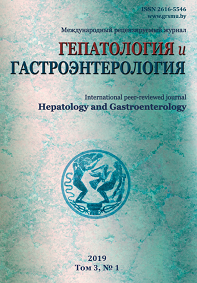COLLAGEN TYPE IV IN THE DETECTION OF THE EROSIVE ESOPHAGEAL DAMAGE IN PATIENTS WITH GASTROESOPHAGEAL REFLUX DISEASE

Abstract
Background. Searching for biomarkers of erosive esophageal damage in patients with gastroesophageal reflux disease (GERD) seems to have scientific and clinical significance.The objective of the study was to evaluate plasma collagen type IV levels in patients with GERD according to the nature of esophageal mucosa damage.
Materials and methods. 90 patients have been examined: 64 with GERD, 26 of the control group. Esophagogastroduodenoscopy with biopsy of the lower third of the esophagus was performed. The collagen type IV level was evaluated in 51 patients using enzyme-linked immunosorbent assay. To determine the threshold level of collagen type IV indicating the presence of erosive esophageal damage in patient with GERD mathematical model has been created.
Results. Patients with erosive esophageal damage have higher plasma levels of collagen type IV concentration than patients with nonerosive GERD and those of the control group. According to the logistic model and ROC analysis patients with plasma collagen type IV level equal or more than 6,08 ng/ml have a high risk of erosive esophageal damage, accuracy 91,89%, sensitivity 90,91%, specificity 92,31%.
Conclusion. Collagen type IV level can be regarded as a biomarker of erosive esophageal damage in patients with GERD. Plasma collagen type IV level equal or more than 6,08 ng/ml indicates the presence of erosive esophageal damage in patient with GERD.
References
1. Balukova EV. Vozmozhnosti preparatov vismuta v lechenii gastrojezofagealnoj refljuksnoj bolezni [Possibilities of bismuth drugs in the treatment of gastroesophageal reflux disease]. Terapija [Therapy]. 2017;17(7):102-108. (Russian).
2. Vjalov SS, Chorbinskaja SA. Gastrojezofagorefljuksnaja bolezn (GJeRB): diagnostika, lechenie i profilaktika [Gastroesophagoreflux disease (GERD): diagnosis, treatment and prevention]. Moskva: Izdatelstvo RUDN; 2011. 21 p. (Russian).
3. Maev IV, Vjuchnova ES, Lebedeva EG, Dicheva DT, Antonenko OM, Shherbenkov IM. Gastrojezofagealnaja refljuksnaja bolezn [Gastroesophageal Reflux Disease]. Moskva: VUNCMZ RF; 2017. 17 p. (Russian).
4. Gain JM, Demidchik JE. Hirurgicheskie bolezni: simptomy i sindromy [Surgical diseases: symptoms and syndromes]. Vol. 1. Minsk: Belaruskaja nauka; 2013. р. 21. (Russian).
5. Mastykova EK, Konorev MR, Matveenko ME. Pishhevod Barretta v strukture gastrojezofagealnoj refljuksnoj bolezni: sovremennye predstavlenija [Barrett’s esophagus in the structure of gastroesophageal reflux disease: current views]. Vestnik Vitebskogo gosudarstvennogo medicinskogo universiteta. 2010;9(4):65-74. (Russian).
6. Savarino E, Bredenoord A, Fox M, Pandolfino J, Roman S, Gyawali C. Expert consensus document: Advances in the physiological assessment and diagnosis of GERD. Nature Reviews Gastroenterology & Hepatology. 2017;14(11):665-676. doi: 10.1038/nrgastro.2017.130.
7. Savarino E, Bredenoord AJ, Fox M, Pandolfino JE, Roman S, Gyawali CP. Expert consensus document: Advances in the physiological assessment and diagnosis of GERD. Nat Rev Gastroenterol Hepatol. 2017;14(11):665-676.
8. Gyawali C, Kahrilas P, Savarino E, Zerbib F, Mion F, Smout A, Vaezi M, Sifrim D, Fox M, Vela M, Tutuian R, Tack J, Bredenoord A, Pandolfino J, Roman S. Modern diagnosis of GERD: the Lyon Consensus. Gut. 2018;67(7):1351-1362. doi: 10.1136/gutjnl-2017-314722.
9. Ahmetov TV, Petrov SV, Burmistrov MV, Sigal EI, Ivanov AI, Muravev AY. Sovremennaja morfologicheskaja ocenka pishhevoda Barretta i raka pishhevoda [Modern morpho-logical evaluation of Barretts esophagus and esophageal cancer]. Prakticheskaja medicina [Practical medicine]. 2008;2(26):6-8. (Russian).
10. Kajbysheva VO, Kucherjavyj JuA, Truhmanov AS, Storonova OA, Konkov MJu, Maev IV, Ivashkin VT. Rezultaty mnogocentrovogo nabljudatelnogo issledovanija po primeneniju mezhdunarodnogo oprosnika GerdQ dlja diagnostiki gastrojezofagealnoj refljuksnoj bolezni [The results of a multicenter observational study about the use of the GerdQ international questionnaire for the diagnosis of gastroesophageal reflux disease]. Rossijskij zhurnal gastrojenterologii, gepatologii, koloproktologii [Russian Journal of Gastroenterology, Hepatology, Coloproctology]. 2013;23(5):15-23. (Russian).
11. Shishko VI, Petrulevich JuJa. Gastrojezofagealnaja refljuksnaja bolezn: klassifikacija, klinika, diagnostika, principy lechenija (obzor literatury, chast 2) [Gastroesophageal reflux disease: classification, clinic, diagnosis, principles of treatment (literature review, part 2]. Zhurnal Grodnenskogo gosudarstvennogo medicinskogo universiteta [Journal of the Grodno State Medical University]. 2015;50(2):15-23. (Russian).
12. Rafiee P, Ogawa H, Heidemann J, Li MS, Aslam M, Lamirand TH, Fisher PJ, Graewin SJ, Dwinell MB, Johnson CP, Shaker R, Binion DG. Isolation and characterization of human esophageal microvascular endothelial cells: mechanisms of inflammatory activation. Am J Physiol Gastrointest Liver Physiol. 2003;285(6):1277-1292. doi: 10.1152/ajpgi. 00484.2002.
13. Boudko SP, Danylevych N, Hudson BG, Pedchenko VK. Basement membrane collagen IV: Isolation of functional domains. Methods Cell Biol. 2018;143:171-185. doi: 10.1016/bs.mcb.2017.08.010.
14. Mastickij SJe, Shitikov VK. Statisticheskij analiz i vizualizacija dannyh s pomoshhju R [Statistical analysis and data visualization with R]. Moskow: DMK; 2015. 496 p. (Russian).
15. Pannal P, Marshall W, Jabor A, Magid E. A strategy to promote the rational use of laboratory tests. Clinica Chimica Acta. 1996;244:121-127.

















1.png)






